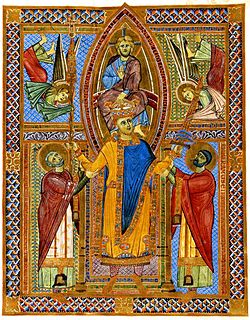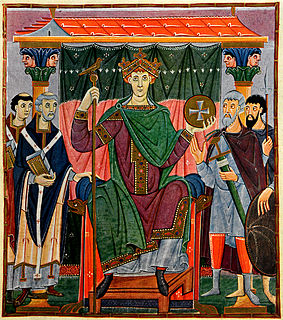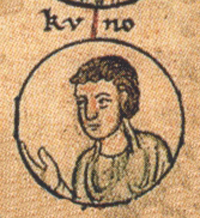Notes
- ↑ Paola Novara (1995), "Federico" Dizionario Biografico degli Italiani, vol. 45 (Rome: Istituto dell'Enciclopedia Italiana).
Frederick (died June 1004) was the Archbishop of Ravenna briefly from 1002 to 1004. [1]
Frederick, a Saxon, first appears as a collaborator of the Emperor Otto III in 1000, when he was present at the reconsecration of Pomposa Abbey in Ravenna. In April 1001 he was appointed a presbyter and a cardinal. In June 1002 he was sent as an imperial legate to the Synod of Pöhlde to mediate between the claims of Bernard, Bishop of Hildesheim, and Willigis, Archbishop of Mainz, concerning the control of the abbey of Gandersheim. In the fall of that year he was elected Archbishop of Ravenna (before 22 November). On 27 December 1002 he was acting metropolitan at the Second Council of Todi.
In 1004 Frederick supported Henry II of Germany for the Iron Crown of Lombardy, while the magnates elected Arduin. When Henry sent Otto I, Duke of Carinthia, to Italy with a force, Tedald of Canossa and Frederick joined him with armies to secure the Po Valley for Henry. Frederick, with his army, met Henry at Brescia in April, but took no more part in military actions, as he died in June.

The Ottonian dynasty was a Saxon dynasty of German monarchs (919–1024), named after three of its kings and Holy Roman Emperors named Otto, especially its first Emperor Otto I. It is also known as the Saxon dynasty after the family's origin in the German stem duchy of Saxony. The family itself is also sometimes known as the Liudolfings, after its earliest known member Count Liudolf and one of its primary leading-names. The Ottonian rulers were successors of the Germanic king Conrad I who was the only Germanic king to rule in East Francia after the Carolingian dynasty and before this dynasty.

Otto IV was one of two rival kings of Germany from 1198 on, sole king from 1208 on, and Holy Roman Emperor from 1209 until he was forced to abdicate in 1215. The only German king of the Welf dynasty, he incurred the wrath of Pope Innocent III and was excommunicated in 1210.

Year 1002 (MII) was a common year starting on Thursday of the Julian calendar.

Otto III was Holy Roman Emperor from 996 until his early death in 1002. A member of the Ottonian dynasty, Otto III was the only son of the Emperor Otto II and his wife Theophanu.

Conrad II, also known as Conrad the Elder and Conrad the Salic, was Emperor of the Holy Roman Empire from 1027 until his death in 1039. The first of a succession of four Salian emperors, who reigned for one century until 1125, Conrad also served as King of Germany from 1024, King of Italy from 1026, and King of Burgundy (Arelat) from 1033.

The Archbishopric of Magdeburg was a Roman Catholic archdiocese (969–1552) and Prince-Archbishopric (1180–1680) of the Holy Roman Empire centered on the city of Magdeburg on the Elbe River.

Arduin was an Italian nobleman who was King of Italy from 1002 until 1014.

Otto I, called Otto of Worms, a member of the Salian dynasty, was Duke of Carinthia from 978 to 985 and again from 1002 until his death.

Conrad I, a member of the Salian dynasty, was Duke of Carinthia from 1004 until his death.
The Bishopric of Merseburg was an episcopal see on the eastern border of the medieval Duchy of Saxony with its centre in Merseburg, where Merseburg Cathedral was constructed. The see was founded in 967 by Emperor Otto I at the same time in the same manner as those of Meissen and Zeitz, all suffragan dioceses of the Archbishopric of Magdeburg as part of a plan to bind the adjacent Slavic ("Wendish") lands in the Saxon Eastern March beyond the Saale River more closely to the Holy Roman Empire.
Imperial Cathedral is the designation for a cathedral linked to the Imperial rule of the Holy Roman Empire.
Tagino was the third Archbishop of Magdeburg from 1004 until his death.
Walthard was the Archbishop of Magdeburg very briefly from June to August in 1012.

Otto I, traditionally known as Otto the Great, was German king from 936 and Holy Roman Emperor from 962 until his death in 973. He was the oldest son of Henry I the Fowler and Matilda.

Henry II, also known as Saint Henry the Exuberant, Obl. S. B., was Holy Roman Emperor from 1014. He died without an heir in 1024, and was the last ruler of the Ottonian line. As Duke of Bavaria, appointed in 995, Henry became King of the Romans following the sudden death of his second cousin, Emperor Otto III in 1002, was made King of Italy in 1004, and crowned emperor by Pope Benedict VIII in 1014.
The German royal election of 1002 was the decision on the succession which was held after the death of Emperor Otto III without heirs. It was won by Duke Henry IV of Bavaria among accusations of uncustomary practices.

Robert, also spelled Ruotbert or Rotbert, was the archbishop of Trier from 931 until his death. He played a leading role in the politics of both Germany and France, and especially of the Lotharingian territory in between. He was a patron of scholars and writers and a reformer of monasteries.
Filippo da Pistoia, also called Filippo Fontana or anglicized Philip, was an Italian prelate, military leader and diplomat. He was the bishop-elect of Ferrara from 1239 until 1252, bishop-elect of Florence from 1250 until 1251 and archbishop of Ravenna from 1250 until his death. He was the apostolic legate in Germany between July 1246 and March 1247, in Lombardy and the Trevigiana between December 1255 and August 1258 and throughout northern Italy between 1267 and February 1270. He served as podestà (mayor) of Ravenna in 1254.